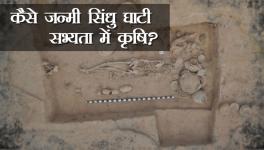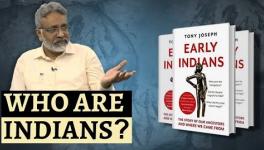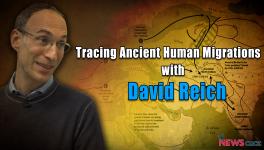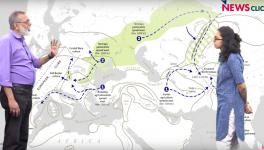Seeing History the Right Side Up: Excerpts from Early Indians

Many of us believe our ancestors have lived in South Asia since "time immemorial". But, as it turns out, "time immemorial" may not have been all that long ago. Tony Joseph's Early Indians: The Story of Our Ancestors and Where We Came From goes 65,000 years into the past–when a band of modern humans, or Homo sapiens, first made their way from Africa into the Indian subcontinent. Citing recent DNA evidence, Joseph traces the subsequent large migrations of modern humans into India. The book not only shows us how the modern Indian population came to be composed as it is but also reveals an undeniable and important truth about who we are: we are all migrants. And we are all mixed.
The following are excerpts from the Epilogue to the book.
Over the four chapters of this book, we saw how the Indian ‘pizza’ got made, with the base or the foundation being laid about 65,000 years ago, when the Out of Africa migrants reached India. The sauce began to be made when the Zagrosian herders reached Balochistan after 7000 BCE, mixed with the First Indians, and then together went on to build the Harappan Civilization. When the civilization fell apart, the sauce spread all over the subcontinent. Then came the ‘Aryans’ after 2000 BCE, and cheese was sprinkled all over the pizza, but a lot more in the north than in the south. Around the same time arrived the major toppings which we see today in different regions in different amounts – the Austroasiatic and Tibeto-Burman-language speakers. And then, much later, of course, came the Greeks, the Jews, the Huns, the Sakas, the Parsis, the Syrians, the Mughals, the Portuguese, the British, the Siddis – all of whom have left small marks all over the Indian pizza.
Like all metaphors this is a silly oversimplification, of course, but is useful to the extent that it helps correct deeply embedded and problematic misconceptions about who we are. It is commonly thought that the ‘adivasis’ or ‘original inhabitants’ or ‘tribals’, who form about 8 per cent of the population, are very distant and very different from the rest of the Indian population – a perception that has led to them being looked down upon, not just as people who have chosen to continue a particular lifestyle, but as people who are ‘not us’. Now we know this is baseless. The tribals are ‘us’.
The tribals share much with the rest of the population genetically since they carry the ancestry of the First Indians and they ought to be seen as the foundational population of India as it is today. As we have seen, 50 to 65 per cent of whole genome ancestry of the Indian population comes from the descendant lineages of the First Indians. And there is no population group in India today that does not carry First Indian ancestry, no matter what language it speaks or where in the caste hierarchy it falls. How appropriate it is then that the most recognizable image of the Harappan Civilization is the ‘dancing girl’ (cover image) who could very well be a tribal girl. As we saw in chapters 2 and 3, First Indians were a part of that first urban revolution. (Aside: We do not know, of course, whether the girl was ‘dancing’; what we do know is that she has a powerfully attractive, insouciant stance that denotes energy and authenticity even today.)
The disdain towards tribals and scheduled castes comes from an inbuilt belief system that ‘others’ them and now we know why this othering needs to go. This attitude also reflects in the general unconcern for our own prehistorical sites. From Jwalapuram to Bhimbetka to Dholavira, the lack of interest in and identification with these sites is almost as palpable as in the case of our western neighbour’s similar indifference to historical sites that predate the arrival of Islam in the subcontinent. We will know that we have matured and owned our past in the full sense when prehistorical sites in India start attracting enough visitors who are excited and thrilled to see what their ancestors did and how they lived.
[…]
The theory that incoming ‘Aryans’ imposed the caste system on the population when they arrived in the subcontinent has been proved wrong by a genetic study published in 2013 titled ‘Genetic Evidence for Recent Population Mixture in India’. It was co-authored by Priya Moorjani, Kumarasamy Thangaraj, Lalji Singh, David Reich and others.
The results of the study that these scientists had conducted, based on genome-wide data from seventy-three population groups in the Indian subcontinent, were stunning. The study showed that between 2200 BCE and 100 CE, there was extensive admixture between the different Indian populations with the result that almost all Indians had acquired First Indian, Harappan and Steppe ancestries, though, of course, to varying degrees. The paper says, ‘India experienced a demographic transformation several thousands of years ago, from a region in which major population mixture was common to one in which mixture even between closely related groups became rare because of a shift to endogamy [marrying within the community].’
We have already seen how, when the Harappan Civilization began declining, as a consequence of the long drought and the arrival of new migrants, there were large-scale population movements from the north-west to both south and east, and much intermixing. So that is not surprising, even though the study reveals that the mixing was quite deep-going: ‘nearly all groups experienced major mixture in the last few thousand years, including tribal groups like Bhil, Chamar and Kallar that might be expected to be more isolated’. What is surprising, because it is counter-intuitive, is that the mixing came to an end sometime around 100 CE. One can imagine two separate groups who had maintained their genetic distance for a long time suddenly deciding that enough was enough and starting to mix. But it is more difficult to visualize groups that had already been mixing waking up one day and deciding to put a stop to it, and creating barriers to continued intermixing. The genetic study says that this is exactly what happened. It was as if around 100 CE a new ideology, which had gained ground and power, imposed on the society new social restrictions and a new way of life. It was social engineering on a scale never attempted before or after, and it succeeded wildly, going by the results of genetic research.
The study links the sudden downing of the shutters on intermixing to the beginning of the caste system: ‘The four-class (varna) system, comprised of Brahmanas, Kshatriyas, Vaisyas, and Sudras, is mentioned only in the part of the Rigveda that was likely to have been composed later. The caste (jati) system of endogamous groups having specific social or occupational roles is not mentioned in the Rigveda at all and is referred to only in texts composed centuries after the Rigveda.’ Could the end of the Maurya empire in the closing centuries of the first millennium BCE have had anything to do with this change in ideology? Did the defeat of the Mauryas also presage the eventual disappearance of Buddhism from the subcontinent and the decline of Jainism? Could the orthodox traditions of Aryavarta – with a more rigid view of social hierarchy and opposition towards ‘varnasankalana’, or mixing between different classes or races – have defeated the more open, freewheeling, progressive and anti-ritualistic ideologies of Magadha that had posed a challenge to it?
Did the rapid expansion of the Maurya empire into the heartland of Aryavarta between the fourth and second centuries BCE threaten the Brahmanical ideology based on sacrifices, the supremacy of Brahmins and their special relationship with rulers, and did Aryavarta strike back in response? Did they, then, over time, manage to impose their own long-held ideals of ‘purity’ and strong endogamy on the rest of society, including the Indo-European-language speakers of eastern India, who did not share those ideals, though they called themselves ‘Aryans’ too? Bronkhorst addresses some of these questions in his book.
A few things follow from this discussion. The caste system in India is not coterminous with the arrival of the ‘Aryans’ in the subcontinent. It fell in place around the ankles of Indian society only about two millennia later. And by the time it came about, intermixing had already taken place to varying degrees. So Ambedkar was right when he stated that the Sudras were not genetically different from the rest of Indian caste society. But perhaps he did not go far enough – he seems to have still considered the tribals to be different from everyone else. We now know that this is not correct – because their genes run through everyone, no matter where in the caste hierarchy one is. Ambedkar was also wrong in denying ‘Aryan’ migrations altogether, though he cannot be blamed for the mistake since he did not have the genome data that we have today.
The cultural effervescence in eastern India or Magadha began in the centuries before the flowering of the Maurya empire and can be seen in such things as urbanization, new religions and philosophies and the rising affluence and prominence of the trading classes. It had already spread its influence and ideas across the subcontinent and far outside of it too, before the gates of the caste system were installed and closed, perhaps over several generations and centuries, thus turning the country inward in many ways.
A period of achievements and adventures
The five or six centuries before the beginning of the Common Era and a couple of centuries after it would rank as one of the most creative and progressive periods in the history of India. The composition of the Upanishads, the insights and philosophy of which have inspired millions across the world and influenced much of the thought of the Indian subcontinent; the rise of the world’s first missionary religions, Jainism and Buddhism, that took the teachings of their founders as well as new linguistic ideas and literary forms to all corners of India and, in the case of Buddhism, to many corners of the then known world; the bringing of east Asia under the spell of Indian cultural ideas; the mesmerizing of China . . . the list is as long as it is exciting. Most of the overseas overtures, outreaches and adventures would have begun either from the eastern or southern parts of India, which would have been without the kind of restrictions on intermixing and voyages across the seas that Aryavarta found necessary to impose.
The momentum of these strong cultural currents carried on for many centuries after a new social hierarchy and a new way of living became common in the subcontinent and mixing between groups of the kind that was seen earlier had become taboo. Sanskrit, as the new language of the elite and the medium of intellectual discourse, probably became more influential than any other language in ancient history, with the possible exception of Latin – and Sanskrit spread more by persuasion and buy-in rather than military invasions as in the case of Latin, as explained beautifully by Sheldon Pollock in his majestic book The Language of the Gods in the World of Men. Kings and aspiring kings all over the subcontinent and across the seas in south-east Asia wanted the prestige and comfort that Sanskrit offered, along with its theory of kingship and social structure that seemed to find a ready market among elites everywhere. A powerful body of literature including the two mega epics, the Ramayana and the Mahabharata, which remain unrivalled in their ability to enthrall and inspire, carried in its sinews the new theory of power and social relationships that was perhaps as convincing for those at the receiving end of it as for those at the giving end of it.
This was not inevitable
But there was also a huge social cost to the new social construct, as indicated by genetics, again, as David Reich explains it in Who We Are and How We Got Here:
People tend to think India with its more than 1.3 billion people as having a tremendously large population, and indeed many Indians as well as foreigners see it this way. But genetically, this is an incorrect way to view the situation. The Han Chinese are truly a large population. They have been mixing freely for thousands of years. In contrast, there are few if any Indian groups that are demographically very large, and the degree of genetic differentiation among Indian jati groups living side by side in the same village is typically two or three times higher than the genetic differentiation between northern and southern Europeans. The truth is that India is composed of a large number of small populations.
In essence, the social structure that was imposed in the second century CE has cut the country into ‘tukde, tukde’ (pieces), to use the vocabulary of television news channel discussions in 2018. When you divide up a people like that, a society’s ability to maximize the potential of its individuals is severely affected and, equally importantly, fellow feeling even among people who live in the same locality is dampened, thus aborting the possibility of common actions that would benefit everyone. To what extent this has hampered India, as a nation, is perhaps a question that only sociologists will be able to answer, hopefully quantitatively, some day.
What we know now is that this was not inevitable. This was not the direction in which India was heading till around 100 CE when we seem to have halted suddenly, and turned back on an issue of crucial social importance. It would be wrong to think, though, that the ideological confrontation between what Aryavarta represented – or perhaps what an elite group within it represented and preferred – and what Magadha or eastern India represented and practised came to an abrupt halt. Buddhism kept going for centuries after its defeat in the land of its birth, though its position grew weaker and weaker.
That some of these battles were still being fought seven centuries after the arrival of the caste system in 100 CE we know from the work of Adi Shankara who took on the philosophies of Buddhism and Jainism. We also know this from archaeological and literary sources that have recorded continuing disputation, both intellectual and physical, and from theological movements like Bhakti that gave voice to the voiceless. That Bhimrao Ambedkar chose Buddhism for himself and his followers when he wanted to challenge still existing inequities in the twentieth century shows how the historical threads of a difference of opinion on the way a society ought to be constructed have continued to this day. In this sense, the spectacular ideological confrontation between Mohandas Karamchand Gandhi and Bhimrao Ambedkar too can be seen as a contest between the best of the philosophy of life and society that the conservative Aryavarta had to offer and the best of the rationality and progressivism that Magadha had to offer.
To quote the historian Romila Thapar:
When we assess our cultural heritage, we often tend to forget or we downplay the fact that rationality and scepticism were very much a part of early Indian thought. This was not limited to the Carvaka/Lokayata thinkers but is also clear from some other schools of philosophy, as indeed it is noticeable in Buddhist and Jaina thought. We have inherited a tradition of questioning, which was not limited to philosophical thought but is apparent in popular literature as well. It would be as well to nurture that tradition.
Tony Joseph, former editor of Businessworld, has been a columnist and contributor to leading newspapers and magazines. He has written many impactful articles on India's prehistory.
Get the latest reports & analysis with people's perspective on Protests, movements & deep analytical videos, discussions of the current affairs in your Telegram app. Subscribe to NewsClick's Telegram channel & get Real-Time updates on stories, as they get published on our website.


















